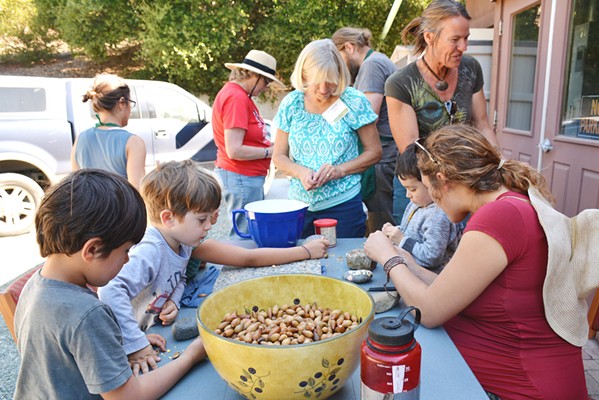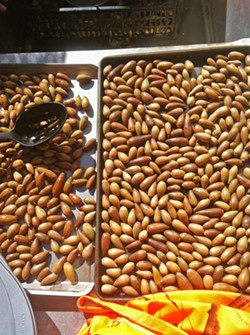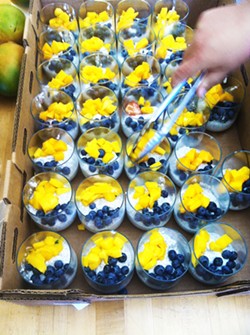Next time you see an acorn on the ground, pick it up. Hold it in the palm of your hand and look closely. Contained inside this almost weightless nut is a tiny seed—and all the blueprints needed to birth a tall, majestic oak tree, hundreds of years in the making.
We often marvel at the ancient Chumash tribe's ability to weave native Central Coast materials into stunningly beautiful baskets—so gorgeous and useful in fact, that early Spanish explorers were known to collect and covet them as priceless treasures.
Still, rarely do we consider the Chumash natives' ability to transform natural Central Coast materials into food. Sure, the Chumash fished local waters and hunted native game, but their most reliable snack—the one that helped sustain the tribe 365 days a year—was small yet mighty, with a glossy, leathery finish and a teeny, bumpy hat. Yes. Acorn meat: It's what's for dinner.

- Photo Courtesy Of Slo Botanical Garden
- GET THAT NUT Acorn processing time means plenty of socializing at the Chumash Kitchen held at the SLO Botanical Garden. An upcoming cooking class is slated for Feb. 3 and promises to get locals in touch with native herbs and how to incorporate them into modern techniques.
This took many hours of gathering, of course. A large basket of nuts would be overturned on a flat rock and cracked open with an oval stone, caps and shells discarded. After much toil, the nut meat was placed into raised storage containers and allowed to dry. Once ready, the meat was ground into flour and placed over a strainer of leaves and grass for leeching.
Repeatedly pouring hot water over the meal allowed the bitter tannins to seep away, leaving just the nutrient-dense, nutty flavor. In the mood for gruel? Heat a few stones over the fire then drop them into a watertight basket filled with moist acorn meal. The Chumash also flattened the floury substance into cakes, allowing the morsels to cook along the edges of the fire.

- Photo Courtesy Of Slo Botanical Garden
- ANCIENT SNACKTIME Acorns are gathered for leeching, grinding, and devouring. These oak nuts may be small, but they are packed with B vitamins, including niacin, thiamin, riboflavin, and vitamin B12.
Can you imagine how welcome a just-cooked acorn cake must have been on a moonless winter night, a week after the last of the cured deer meat had run out? Can you imagine nibbling the smoky, browned edges under a blanket of bright stars?
Learn to understand this history, and cook in harmony with the Central Coast seasons, at the next Chumash Kitchen cooking class, slated for Saturday, Feb. 3. Held at the SLO Botanical Garden, the Winter Health and Trinity Plants event encourages all of us to get in touch with the wisdom of the seasons.
You might just discover a surprising bounty of winter foods growing right under your nose (and learn to integrate healing herbs into your diet to ward off seasonal colds). Led by Chumash chefs and herbalists Violet Cavanaugh and Jeanette Acosta, you'll get your hands on a trinity of healing herbs: Yerba Buena, Yerba Santa, and Yerba Mansa, while enjoying a stunningly prepared breakfast and lunch featuring the local flavors of the season. Did I mention, you'll enjoy a quick hike among the greenery and tea time with roses?
Violet Cavanaugh is co-chair of the Northern Chumash Tribal Council and is known around local farmers' markets for her Native Herbs and Honey products crafted on her farm in Los Osos. Born and raised in Avila Beach, she is the great-granddaughter of Chumash Vaquero Antonio Lopez of Lopez Canyon. She grew up riding horses in the mountains of her traditional homeland, where she learned all she could about herbs from her grandmother.
Like her ancestors, Cavanaugh knows the seasons like the back of her hand, and she wants to share this knowledge with anyone who will listen.
"In this class, you'll learn how to create gourmet dishes with local indigenous foods you can gather in your yard or near where you live," Cavanaugh said. "We wanted to partner with the SLO Botanical Garden, who has good ties to the community and already promotes permaculture and cooking with local botanicals. This is really about being able to create community through food."
A previous class dedicated to acorns featured a five-course meal of squash, wild rice, quinoa, savory acorn gravy, house-made fire cider, and greens roasted with wild sage. For dessert? A gluten-free apple pie with chia seeds, local honey, and an acorn crumble topping (even the ice cream was served with a crunchy acorn granola on top).
Cavanaugh said that although the food in these classes is undeniably delicious, it's not just about eating good, healthy food—or even promoting seasonal, local fare.
It's about creating a more lush picture of what native Chumash people ate—and continue to eat—in connection with their rich past.
"I think people have a very dumbed-down image of what we eat, and if people knew we had wild salmon encrusted in crunchy acorn and figs roasted over a fire and blackberry cobbler, they might want a taste," she said. "Showing the diversity of flavors, and what's possible with native cooking and indigenous foods—that's the goal."
Lindsey Collinsworth Morgan agreed, adding that yet another layer is delightfully nerdy and hands-on. How often do any of us really "work" for our dinner? How often to we go out and forage for our greens?
"Going through the whole process from finding the plant, picking the pieces, processing them, and then incorporating them so nicely into modern recipes—and the reverence that is given to these plants—it just gives you this whole new appreciation," she said. "There's that realization that, 'Wow. This is how long it took to harvest this amount of manzanita berries.'"
To this end, there's a special "meal prep" class on Friday, Feb. 2, allowing attendees to gain that deeper appreciation of each herb.
"We want to show respect for the herbs and respect for the cycles of nature. The most important thing for us to remember is, if we don't tell people why things are important, they won't protect them," Cavanaugh said.

- Photo Courtesy Of Slo Botanical Garden
- NATURE KNOWS BEST All natural chia pudding topped with indigenous Central Coast ingredients gave education a sweet flavor at a past Chumash Kitchen event. The next event, on Feb. 3, is all about working with healing herbs.
Yes, it's a lofty task. But you may better understand the scope of Chumash spiritual lands, important water sources, coastlines, species of fish, and revered plants just by attending a simple class. Or, at the very least, your door may open more fully to these ideas.
To truly learn the Chumash way, you can't simply read, click, or "like."
You must do, listen and experience.
"We were taught all this wisdom through our oral traditions, which are then passed down. Most of our beliefs are not written down in books," Cavanaugh said. "When we cook, we show respect to those that were there before us and show appreciation for the sacredness and significance of the area. We know our students then go out into the community and are more aware of why this land is important. We are developing an army of caretakers, one class at a time." Δ
Hayley Thomas Cain is (attempting to) forage for her dinner. She can be reached at [email protected].
Comments